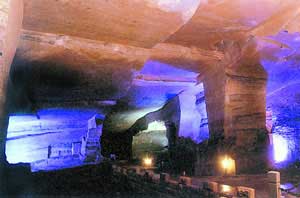2006 03 09
From: Shanghai Star
 Is it simply a coincidence or do certain laws of nature lie behind the phenomenon? A new mystery has recently been uncovered on the 30 degrees Northern Latitude, following upon other great mysteries such as the pyramids, Noah's ark and the Bermuda Triangle.
Is it simply a coincidence or do certain laws of nature lie behind the phenomenon? A new mystery has recently been uncovered on the 30 degrees Northern Latitude, following upon other great mysteries such as the pyramids, Noah's ark and the Bermuda Triangle.
The new finding on this mysterious latitude is to do with the ancient Mystical Caves at Huashan, near the famous Huangshan Mountain in China's Anhui Province. Although tests on chiselled stones showed that the caves have existed for at least 1,500 years, it was only about 15 months ago that they were first discovered by a local farmer, by accident.
The neatly chiselled walls and roofs, the big pillars and stone stairs, indicate that the caves were dug by men. Yet nobody knows for what purpose the ancient people excavated them. Not a single word about the caves has ever been found among China's numerous ancient records although their size has already ranked them as the biggest ever discovered so far in China.
Altogether, 36 caves have been found among the rolling Huashan hills, near the crystal-clear Xin'an River. Two of the caves are now open to visitors. The rest are still being cleaned of the mud that has accumulated inside. According to the excavation workers, there is a high possibility that the 36 caves may be connected to one another.
Huanxi cave, with a length of 140 metres and a size of 4,800 square metres, is one of the two now open to public. After a walk of 100 metres, you find a grand hall inside the cave, with pools, pillars and small rooms on each side.
A most mysterious discovery is the slope of the cave. The inclined plane of the walls has exactly the same slope as the outside hill. Yet according to the technology of that time, how could the ancient people have managed that?
Of all the 36 caves, the biggest is the Qingliang Cave, which is known as the "Underground Palace" due to its scale and magnificent layout. With a total length of 170 metres, the cave covers a space of 12,600 square metres. The original digging-out of the cave could have produced at least 50,000 cubic metres of stone.
Inside the cave there is a stone bridge above an underground river and with stone paths leading to different halls. A two-storey stone structure is nearby where visitors have a bird's eye view of the huge cave from a balcony. No food remains were found in the cave, nor any smoking or signs of fire. But without fire how could the ancient diggers have produced light in the cave?
Wild guesses
As there are no historical records telling why the ancient people dug the caves, a variety of guesses are made by tourists as well as by experts.
Some people hold that the ancient people dug the caves just to produce stone as, at that time, a large quantity of stone was needed to build the town. But if it was only for stone, why did they leave exquisite smoothed chisel marks on the walls and roofs?
Another hypothesis is that the caves were used to station troops. According to history texts, a large-scale peasant uprising occurred near the caves in 1120. The caves could have been the place to station soldiers.
Yet as mentioned before, the stone tests showed that the caves have a history as long as 1,500 years, so the caves were already there before the peasant uprising.
Some hold that the caves were not the project of one dynasty or one period. They might have been dug out over hundreds of years. During the initial period, they were excavated just for the stone. But later people found the caves and after further digging, they made them bigger and longer for hiding in, stationing troops or simply as stock houses. This hypothethis well explains why even the same cave has different patterns of calving and different chisel marks.
Apart from all these hypotheses, there are many other guesses - for instance the caves might have been imperial tombs. But, later for whatever reason, the caves were abandoned.
All these unanswered questions place a shroud of mystery over the caves, as well as adding more fun to the trip.
Article from: http://app1.chinadaily.com.cn/star/2003/0109/tr17-1.html
